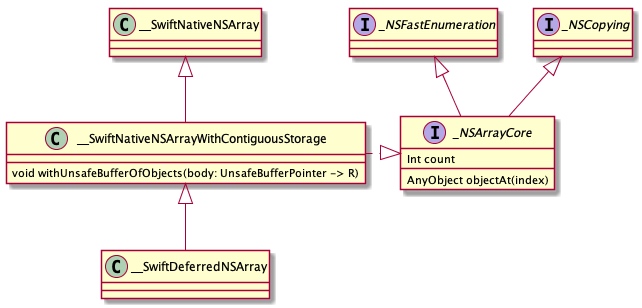Swfit 里 Array(五)和 NSArray 转换
 

只看 Swift Array 到 NSArray
Array 里的源代码
extension Array {
@inlinable
public // @SPI(Foundation)
func _bridgeToObjectiveCImpl() -> AnyObject {
return _buffer._asCocoaArray()
}
}
这里看到,调用了_asCocoaArray 函数。
#if _runtime(_ObjC)
/// Convert to an NSArray.
///
/// - Precondition: `Element` is bridged to Objective-C.
///
/// - Complexity: O(1).
@inlinable
internal __consuming func _asCocoaArray() -> AnyObject {
if count == 0 {
return _emptyArrayStorage
}
if _isBridgedVerbatimToObjectiveC(Element.self) {
return _storage
}
return __SwiftDeferredNSArray(_nativeStorage: _storage)
}
#endif
如果是空数组
直接返回了一个空的地址,注意所有的空数组都指向了同一个内存地址。
SWIFT_RUNTIME_STDLIB_API
swift::_SwiftEmptyArrayStorage swift::_swiftEmptyArrayStorage = {
// HeapObject header;
{
&swift::CLASS_METADATA_SYM(s19__EmptyArrayStorage), // isa pointer
},
// _SwiftArrayBodyStorage body;
{
0, // int count;
1 // unsigned int _capacityAndFlags; 1 means elementTypeIsBridgedVerbatim
}
};
如果元素类型可以直接转为 Objc
返回真正持有元素的类。
如果元素不能直接转为 Objc
返回一个__SwiftDeferredNSArray 类型。
__SwiftDeferredNSArray 是什么
 

是一个 NSArray 的子类,实现了objectAt(index) 方法。
internal func objectAt(_ index: Int) -> AnyObject {
return withUnsafeBufferOfObjects {
objects in
_precondition(
_isValidArraySubscript(index, count: objects.count),
"Array index out of range")
return objects[index]
}
}
实现的核心在withUnsafeBufferOfObjects方法里。
internal override func withUnsafeBufferOfObjects<R>(
_ body: (UnsafeBufferPointer<AnyObject>) throws -> R
) rethrows -> R {
while true {
var buffer: UnsafeBufferPointer<AnyObject>
// If we've already got a buffer of bridged objects, just use it
if let bridgedStorage = _heapBufferBridged {
let bridgingBuffer = _BridgingBuffer(bridgedStorage)
buffer = UnsafeBufferPointer(
start: bridgingBuffer.baseAddress, count: bridgingBuffer.count)
}
// If elements are bridged verbatim, the native buffer is all we
// need, so return that.
else if let buf = _nativeStorage._withVerbatimBridgedUnsafeBuffer(
{ $0 }
) {
buffer = buf
}
else {
// Create buffer of bridged objects.
let objects = _nativeStorage._getNonVerbatimBridgingBuffer()
// Atomically store a reference to that buffer in self.
if !_stdlib_atomicInitializeARCRef(
object: _heapBufferBridgedPtr, desired: objects.storage!) {
// Another thread won the race. Throw out our buffer.
_destroyBridgedStorage(
unsafeDowncast(objects.storage!, to: __BridgingBufferStorage.self))
}
continue // Try again
}
defer { _fixLifetime(self) }
return try body(buffer)
}
}
这一段的核心在于最后一个else里的内容。
首先创建了一段缓冲区,其中存储了数组中元素被 bridege 到 OC 对象的结果,然后对每一个缓存区中的元素增加一个引用。
分配内存并做转换的代码
/// Bridge array elements and return a new buffer that owns them.
///
/// - Precondition: `Element` is bridged non-verbatim.
override internal func _getNonVerbatimBridgingBuffer() -> _BridgingBuffer {
_internalInvariant(
!_isBridgedVerbatimToObjectiveC(Element.self),
"Verbatim bridging should be handled separately")
let count = countAndCapacity.count
let result = _BridgingBuffer(count)
let resultPtr = result.baseAddress
let p = _elementPointer
for i in 0..<count {
(resultPtr + i).initialize(to: _bridgeAnythingToObjectiveC(p[i]))
}
_fixLifetime(self)
return result
}
下面是对_bridgeAnythingToObjectiveC的注释。
/// Bridge an arbitrary value to an Objective-C object.
///
/// - If `T` is a class type, it is always bridged verbatim, the function
/// returns `x`;
///
/// - otherwise, if `T` conforms to `_ObjectiveCBridgeable`,
/// returns the result of `x._bridgeToObjectiveC()`;
///
/// - otherwise, we use **boxing** to bring the value into Objective-C.
/// The value is wrapped in an instance of a private Objective-C class
/// that is `id`-compatible and dynamically castable back to the type of
/// the boxed value, but is otherwise opaque.
///
// COMPILER_INTRINSIC
public func _bridgeAnythingToObjectiveC<T>(_ x: T) -> AnyObject {
下起雨,也要勇敢前行




